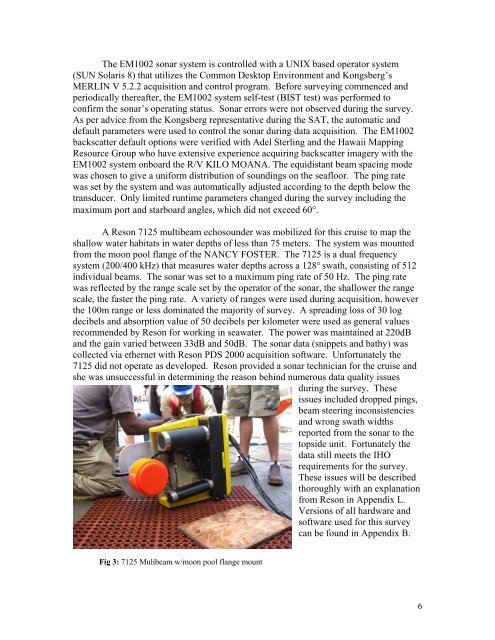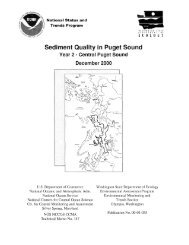Data Acquisition and Processing Report (DAPR) - Center for Coastal ...
Data Acquisition and Processing Report (DAPR) - Center for Coastal ...
Data Acquisition and Processing Report (DAPR) - Center for Coastal ...
Create successful ePaper yourself
Turn your PDF publications into a flip-book with our unique Google optimized e-Paper software.
The EM1002 sonar system is controlled with a UNIX based operator system<br />
(SUN Solaris 8) that utilizes the Common Desktop Environment <strong>and</strong> Kongsberg’s<br />
MERLIN V 5.2.2 acquisition <strong>and</strong> control program. Be<strong>for</strong>e surveying commenced <strong>and</strong><br />
periodically thereafter, the EM1002 system self-test (BIST test) was per<strong>for</strong>med to<br />
confirm the sonar’s operating status. Sonar errors were not observed during the survey.<br />
As per advice from the Kongsberg representative during the SAT, the automatic <strong>and</strong><br />
default parameters were used to control the sonar during data acquisition. The EM1002<br />
backscatter default options were verified with Adel Sterling <strong>and</strong> the Hawaii Mapping<br />
Resource Group who have extensive experience acquiring backscatter imagery with the<br />
EM1002 system onboard the R/V KILO MOANA. The equidistant beam spacing mode<br />
was chosen to give a uni<strong>for</strong>m distribution of soundings on the seafloor. The ping rate<br />
was set by the system <strong>and</strong> was automatically adjusted according to the depth below the<br />
transducer. Only limited runtime parameters changed during the survey including the<br />
maximum port <strong>and</strong> starboard angles, which did not exceed 60°.<br />
A Reson 7125 multibeam echosounder was mobilized <strong>for</strong> this cruise to map the<br />
shallow water habitats in water depths of less than 75 meters. The system was mounted<br />
from the moon pool flange of the NANCY FOSTER. The 7125 is a dual frequency<br />
system (200/400 kHz) that measures water depths across a 128° swath, consisting of 512<br />
individual beams. The sonar was set to a maximum ping rate of 50 Hz. The ping rate<br />
was reflected by the range scale set by the operator of the sonar, the shallower the range<br />
scale, the faster the ping rate. A variety of ranges were used during acquisition, however<br />
the 100m range or less dominated the majority of survey. A spreading loss of 30 log<br />
decibels <strong>and</strong> absorption value of 50 decibels per kilometer were used as general values<br />
recommended by Reson <strong>for</strong> working in seawater. The power was maintained at 220dB<br />
<strong>and</strong> the gain varied between 33dB <strong>and</strong> 50dB. The sonar data (snippets <strong>and</strong> bathy) was<br />
collected via ethernet with Reson PDS 2000 acquisition software. Un<strong>for</strong>tunately the<br />
7125 did not operate as developed. Reson provided a sonar technician <strong>for</strong> the cruise <strong>and</strong><br />
she was unsuccessful in determining the reason behind numerous data quality issues<br />
during the survey. These<br />
issues included dropped pings,<br />
beam steering inconsistencies<br />
<strong>and</strong> wrong swath widths<br />
reported from the sonar to the<br />
topside unit. Fortunately the<br />
data still meets the IHO<br />
requirements <strong>for</strong> the survey.<br />
These issues will be described<br />
thoroughly with an explanation<br />
from Reson in Appendix L.<br />
Versions of all hardware <strong>and</strong><br />
software used <strong>for</strong> this survey<br />
can be found in Appendix B.<br />
Fig 3: 7125 Mulibeam w/moon pool flange mount<br />
6







